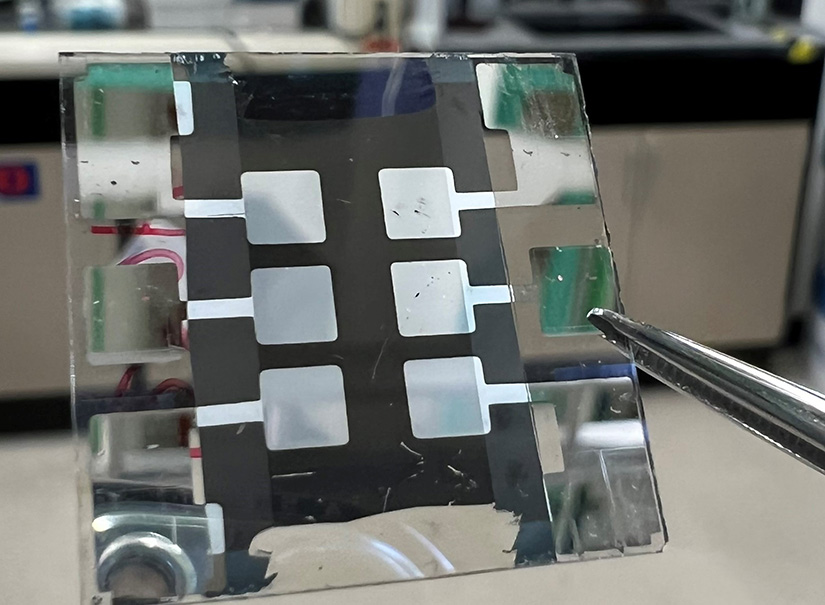A new approach to manufacturing perovskite solar cells developed by researchers at the National Renewable Energy Lab (NREL) addresses previous problems and yielded devices with high efficiency and excellent stability.
Developing highly stable and efficient perovskites based on a rich mixture of bromine and iodine is considered critical for the creation of tandem solar cells. However, issues with the two elements separating under solar cell operational conditions, such as light and heat, limit the device voltage and operational stability. This challenge is often exacerbated by the ready defect formation associated with the rapid crystallization of bromine-rich perovskite chemistry with antisolvent processes.
“This new growth approach can significantly suppress the phase segregation,” said Kai Zhu, a senior scientist at NREL, principal investigator on the project, and lead author of the new paper “Compositional texture engineering for highly stable wide-bandgap perovskite solar cells.” His co-authors from NREL are Qi Jiang, Jinhui Tong, Rebecca Scheidt, Amy Louks, Robert Tirawat, Axel Palmstrom, Matthew Hautzinger, Steven Harvey, Steve Johnston, Laura Schelhas, Bryon Larson, Emily Warren, Matthew Beard, and Joseph Berry. Other researchers involved are with the University of Toledo.
The new approach addressed the problem of the two elements separating, and it produced a wide-bandgap solar cell with an efficiency of greater than 20% and 1.33-volt photovoltage. Little change was seen in the efficiency over 1,100 hours of continuous operation at a high temperature. Ultimately the researchers achieved an all-perovskite tandem cell obtained an efficiency of 27.1% with a high photovoltage of 2.2 volts and good operational stability.
In the tandem cell, the narrow-bandgap layer is deposited on top of the wide-bandgap layer. The difference in bandgaps allows for more of the solar spectrum to be captured and converted into electricity.
The newly developed approach builds upon work Zhu and his colleagues published earlier this year that flipped the typical perovskite cell. Using this inverted architectural structure allowed the researchers to increase both efficiency and stability and to easily integrate tandem solar cells. They ultimately achieved a perovskite solar cell with 24% efficiency that retains 87% of output after 100 days.
In the recent research study, the NREL-led group used that same architecture in that they used an antisolvent applied to the crystalizing chemicals to create a uniform perovskite film. Then they went a step further, and the new approach relied on what is known as gas quenching, in which a flow of nitrogen was blown onto the chemicals. The result addressed the problem of the bromine and iodine separating, resulting in a perovskite film with improved structural and optoelectronic properties.
The previous antisolvent approach allows the crystals to grow rapidly and uniformly within the perovskite film, crowding each other and leading to defects where the grain boundaries meet. The new gas-quenching process, when applied to high-bromine-content perovskite chemicals, forces the crystals to grow together, tightly packed from top to bottom. The researchers found that this significantly decreases the defects. The top-down growth method forms a gradient structure, with more bromine near the top and less in the bulk of the cell. The researchers report that the gas-quench method was also statistically more reproducible than the antisolvent approach.
The researchers also tried argon and air as drying gas with similar results, indicating that the gas-quench method is a general way for improving the performance of wide-bandgap perovskite solar cells.
The new growth approach demonstrated the potential of high-performance all-perovskite tandem devices and advanced the development of other perovskite-based tandem architectures such as those that incorporate silicon.
The work is reported in the new issue of the journal Science.
This content is protected by copyright and may not be reused. If you want to cooperate with us and would like to reuse some of our content, please contact: editors@pv-magazine.com.









By submitting this form you agree to pv magazine using your data for the purposes of publishing your comment.
Your personal data will only be disclosed or otherwise transmitted to third parties for the purposes of spam filtering or if this is necessary for technical maintenance of the website. Any other transfer to third parties will not take place unless this is justified on the basis of applicable data protection regulations or if pv magazine is legally obliged to do so.
You may revoke this consent at any time with effect for the future, in which case your personal data will be deleted immediately. Otherwise, your data will be deleted if pv magazine has processed your request or the purpose of data storage is fulfilled.
Further information on data privacy can be found in our Data Protection Policy.